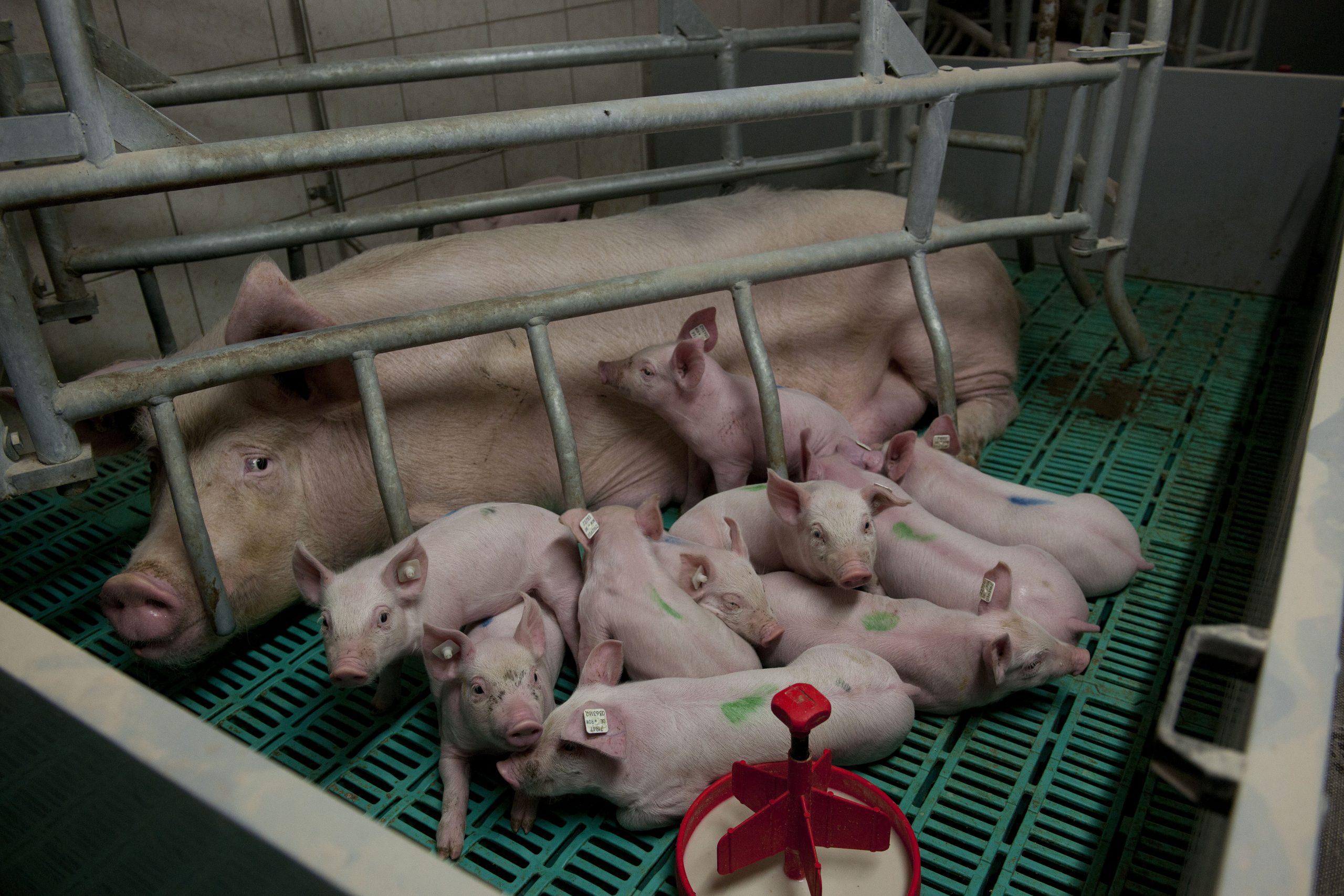Facing post-weaning diarrhoeas

Post-weaning diarrhoea is a common problem in swine farms. Which farm has never experienced it? A combination of different factors predisposes the pig to this type of condition but what solutions are available in a post-antibiotic and zinc oxide world?
Weaning puts pigs in a different scenario: no protection from their mother, neither physically nor psychologically; nobody calls them to eat, food is less digestible as it includes raw vegetable materials, it is often presented in a dry form and often the water supply is located far away from where the food is; they must learn how to use new feeders and drinkers; they are commingled with other litters and, as a consequence, exposed to other bacteria and viruses.
As a result of all these changes, some piglets will not eat for a period of time, which can be hours or even days. They will feel cold, their body will try to adapt to this new condition by reducing the use of energy and protein as much as possible and therefore lowering the replacement rate of the intestinal epithelial cells, resulting in a shortening of the intestinal microvilli. Finally, however, they will try the feed, they will like it and they will eat a large quantity. Their stomach however is not prepared to receive big quantities of food since they were used to eating several times a day during lactation. The time spent by the food in the stomach will be shorter and the pH obtained will not be the right one to activate protein enzymes to digest vegetable protein. Food will not be digested adequately in the intestine nor will it be well-absorbed, as the villi surface has been reduced. The risk of diarrhoea will increase and, in fact, will be a reality in many cases (Figure 1).
For many years, the solution to this type of problems has been based on using antibiotics or zinc oxide in pre-starter and starter diets, with the aim of controlling those bacteria which will take advantage of food which has not been well digested or absorbed in the pig’s intestine. But this type of strategies will soon be no longer available in Europe.
Modern medicine threatened
The development of antimicrobial resistance is a normal evolutionary process for micro-organisms, but the selection pressure created by the routine use of antibiotics accelerates it. This problem threatens the achievements of modern medicine, as the pipeline for the development of new antibacterial drugs is nearly empty. Limiting the use of antimicrobial drugs in human and veterinary practice can minimise the development of resistance. Following the discovery of a new colistin horizontally transferable resistance mechanism (MCR-1), and considering the rapidly increasing importance of colistin for the treatment of critically ill human patients, the European Medicines Agency recommended that all countries should strive to reduce the use of polymyxins as much as possible. In parallel, the European Medicines Agency also recommended the refusal of new marketing authorisations and the withdrawal of the existing marketing authorisations for veterinary medical products containing zinc oxide. The recommendation is primarily based on the risk for the environment in addition to the possible risk of co-selection for antimicrobial resistance associated with the use of zinc oxide.
What are the alternatives?
Alternatives to antibiotics and zinc oxide are wide, but probably there is not one as powerful, consistent in their results and easy to apply as them. Amongst the different alternatives, the following will be explored here highlighted: management, feed formulation, vaccines, organic acids, enzymes, prebiotics, probiotics and phytogenic feed additives.
Management
Management is probably the best alternative, but it is not so easy to apply as it includes many different aspects. Probably the most important management improvement is teaching the pig how to eat feed. We already know that if pigs know how to eat and drink before weaning, the fasting period after is reduced and with it, all the problems derived from it. Training the young pig to eat should start very early on, during lactation. But to stimulate them to eat creep feed it should include not only nutritional skills in order to formulate an attractive and digestible diet, but also have a presentation which allows them to take feed and water at the same time, like they do when they drink milk from their mother. Liquid presentation in a concentration similar to their mother’s milk will make training easier as they just have to take everything they need from one place.
Liquid presentation will increase feed intake while they are still lactating, allowing them to achieve their maximum genetic potential (Figure 2). Liquid feeding presentation before weaning is not as simple as it seems, since it must guarantee that the feed remains clean and attractive to the piglets.
Figure 2 – Liquid vs. dry diet.

The more they eat pre-weaning, the shorter the fasting period post-weaning will be, increasing post-weaning feed intake and in consequence, reducing the risk of diarrhoea (Figure 3). Management has to ensure good hygiene and environment once the pigs are weaned and located in nurseries. They have to find the feed and water as easily as possible, and feeders have to allow them to eat in groups, like during lactation.
Figure 3 – Relationship between fasting period and pre-weaning eating.

Vaccines
A live E. coli vaccine was recently launched in the EU market. It has to be administered orally to the piglets and it is intended for the active immunisation of pigs against enterotoxigenic F4 and F18 positive E.coli, the most important agents in post-weaning diarrhoea. In a study done in Bulgaria in which the etiology of post-weaning diarrhoea problems was investigated, from 619 isolated and identified strains, 66.1% were toxin-producing E. coli. Out of them, 87.4% possessed the adhesion factor F18 while the rest were type F4.
Feed formulation
Highly digestible diets have always been looked upon as a good tool to prevent digestive problems. The availability of synthetic amino-acids has made it possible to formulate low crude protein diets which are considered safer, but the pig’s performance remains unaltered. But even low protein diets will not totally prevent protein fermentation in the gut, as the digestibility of the protein will not be 100%. Nutritionists have been investigating other methods to avoid the negative effects of protein fermentation and based on some experimental results, it seems that including higher levels of fibre could help in maintaining intestinal stability. There is still a lot to learn about which type or what level of fibre would be the most interesting in post-weaning diets, but as investigation continues, it will become clearer what the best strategy should be (Figure 4).
Acidifiers
Amongst a variety of candidates for the replacement of antibiotics, organic acids have been broadly applied worldwide with reasonable success. Adding organic acids (fumaric, propionic, citric, etc.) to nursery diets has been shown to improve daily gain and feed conversion responses during the early nursery period. Dietary acid inclusion may be particularly beneficial when there is a problem with E. coli in the nursery. The mechanism of action is not clear, but it may be related to a reduction in the pH in the upper intestinal tract, thereby reducing the potential for proliferation of undesirable micro-organisms in the stomach and small intestine.
Organic acids may help the intestinal mucosa to maintain its integrity, they reduce the buffering capacity of the diets helping to keep stomach pH low, resulting in increased pepsin activity and slowing of stomach emptying. When protected they can reach more distal portions of the intestine, reducing Salmonella carriers at farm level when used in finishing. Acidifiers are routinely used in nursery diets and their effect can be improved by combining them with other feed additives.
Enzymes
Mixtures of cellulases, hemicellulases and proteases are sometimes added to feeds in an attempt to improve the digestibility of complex carbohydrates and proteins. In areas where barley or rye are used, β-glucanase and pentosanases are sometimes included to degrade the β-glucans and pentosans (complex carbohydrates that interfere with digestibility of other nutrients) found in these cereal grains. Improving feed digestibility has been seen as a possible way to reduce intestinal problems. When looking for possible alternatives to control post-weaning diarrhoea, enzymes appear to be a promising one. A variety of solutions have been detected in the enzyme hydrolysis products, which can be interesting in maintaining intestinal health. In an experimental study, piglets fed with these enzyme hydrolysis products were compared versus controls when they were orally challenged with ETEC. During the challenge period, piglets fed hydrolysis products consumed more feed and had lower incidences of diarrhoea. Other experimental studies found that the attachment of E. coli F4 (K88) to the pig’s small intestine was inhibited when an exogenous protease was orally administered, in a dose dependant manner. Probably, in the near future we will see much more data appearing in relation to the best enzyme combination for a specific diet, in order to obtain the best results in maintaining intestinal health.
Pre- and pro-biotics
Probiotics are live micro-organisms: living bacteria or yeast cultures. They have existed for a long time but the documented evidence of their prophylactic or therapeutic effect on post weaning diarrhoea has been very variable. These variable results are probably due to the variable viability of cultures, dose differences, strain differences, possible interaction with diet substances and possible interaction with microbiota, etc. Prebiotics are substances which may favour the growth of certain micro-organisms present in pig microbiota. The advantage of favouring these particular bacteria is similar to probiotics and the problems with their use are also similar.
At this moment, more investigation is needed in order to understand why these variable results are produced. It is clear that under certain conditions they can be very useful as some of the data show, but we have to know why in order to have more consistent results under field conditions. As the understanding of pig microbiota is increased, so will the understanding of pre- and probiotics.
Phytogenic feed additives
These are compounds derived from plants or parts of them (leaves, roots, flowers, etc). Recent interest has focused on these products as they may have antimicrobial, antiparasite or antioxidant properties. The problems with this type of feed additives are often associated with the lack of standardisation of active ingredient extraction, their potency or inclusion level. More scientific based research is necessary in order to know how to use these products better and what the benefit derived from their use will be.
Power comes from combinations
Among the alternatives available today to substitute antimicrobials and zinc oxide in diets, there is not one as powerful as they are individually. The solution has to rely on using different combinations of them. In these combinations, we cannot avoid including acidifiers and enzymes; the rest will be part of the small differences between different feed producers. However, it should not be forgotten that no additive can substitute good management.
References available on request











